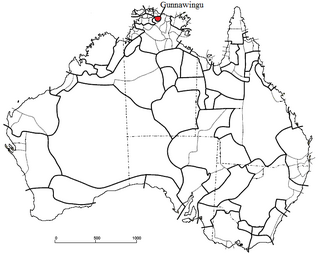This page is based on this
Wikipedia article Text is available under the
CC BY-SA 4.0 license; additional terms may apply.
Images, videos and audio are available under their respective licenses.
The Bakanambia, also known as the Wanbara, are an Aboriginal group of Australia. Traditionally, the Bakanambia lived in the vicinity of Princess Charlotte Bay in the state of Queensland. One of the ethnonyms applied to them was Lama Lama, which is now used of a larger aggregation of remnants of several tribes.

The Awabakal people, a group of indigenous people of New South Wales, are those Aboriginal Australians who identify with or are descended from the Awabakal tribe and its clans scattered along the coastal area of what is now known as the Mid North Coast region of New South Wales. Their traditional territory spread from Wollombi in the south, to the Lower Hunter River near Newcastle and Lake Macquarie in the north.

The Gunwinggu people are a tribe of Australian Aboriginal people, forming part of the Bininj Gun-Wok peoples, who live to the east of Darwin, Northern Territory.
The Mati Ke otherwise known as the Magatige, are an indigenous Australian people, whose traditional lands are located in the Wadeye area in the Northern Territory, Their language is in danger of extinction.
The Marrithiyal, also written Marithiel, are an indigenous Australian people whose traditional territory lay 30 to 50 miles south of the Daly River in the Northern Territory. They were sometimes known derogatively as Berringen(Berinken/Brinken), a term used by the Mulluk-Mulluk to refer to 'aliens'/strangers'.
The Nangiomeri, or Nanggumiri, were an indigenous Australian people who lived in the area of the Daly River in the Northern Territory.
The Marranunggu are an indigenous Australian people, and language group, of the Northern Territory.
The Marimanindji are an indigenous Australian tribe of the Northern territory. Little is known of them.
The Mariamo or Marri ammu are an indigenous Australian people of the Northern Territory.
The Methne, occasionally called Menthajangal (Menhdheyangal), are an indigenous Australian people of the Northern Territory.
The Wadjiginy, also referred to historically as the Wogait, are an indigenous Australian people of the Northern Territory.
The Djerimanga, also known as the Wulna, are an indigenous Australian people of the Northern Territory.
The Dalabon or Dangbon are an indigenous Australian people of the Northern Territory.
The Mangarayi, also written Mangarai, were an indigenous Australian people of the Northern Territory.
The Arnga are an indigenous Australian people of the northern Kimberley region of Western Australia.
The Yeidji, otherwise commonly known as the Gwini, are an indigenous Australian people of the Kimberley area of Western Australia.
The Wunambal are an indigenous Australian people of the northern Kimberley region of Western Australia.
The Ngarti, also spelled Ngardi, are an indigenous Australian people of the Northern Territory and Western Australia.
The Malngin were an indigenous Australian people of Western Australia. The Malngin language was a dialect of Gurindj.
The Djerait were an indigenous Australian people of the Northern Territory




